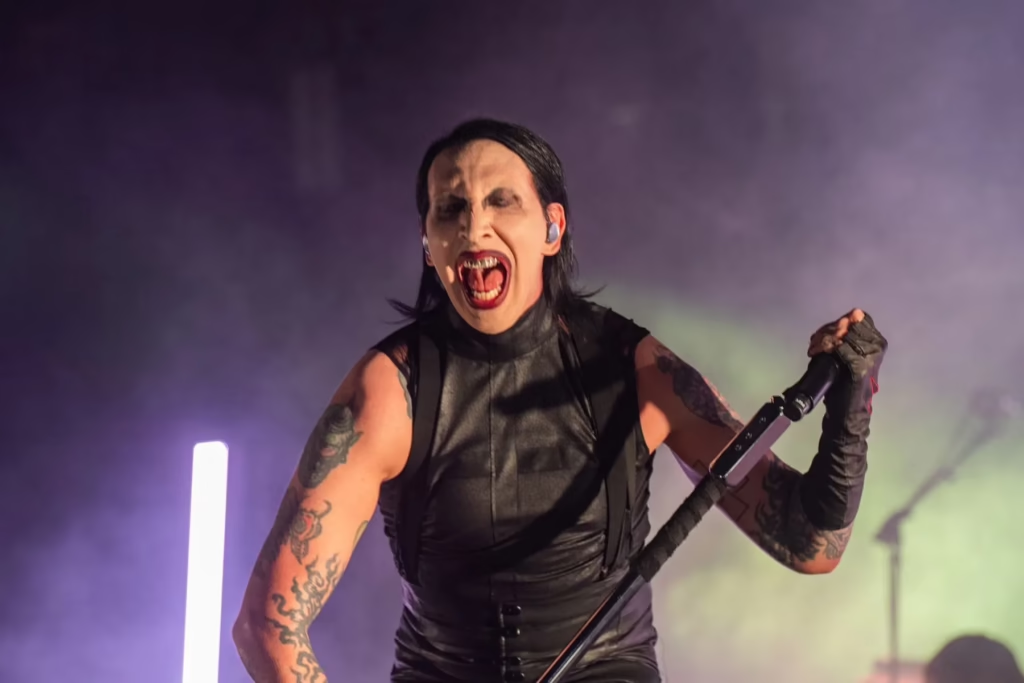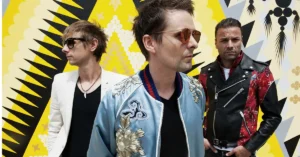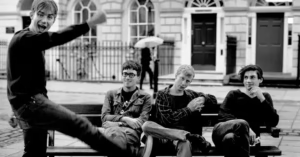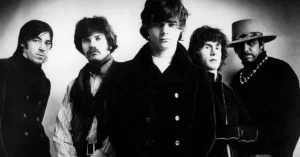Marilyn Manson: The Shock Rock Prophet of Modern Darkness
Marilyn Manson. Introduction: Art, Controversy, and Identity
Few artists in modern rock have evoked as much fascination, fear, and debate as Marilyn Manson. With a career rooted in performance art, industrial rock, and social provocation, Manson blurred the lines between persona and performer. Emerging in the 1990s with a violent aesthetic, gothic imagery, and an unforgiving critique of American society, he became the embodiment of cultural rebellion—and a lightning rod for media hysteria.
From his provocative lyrics to his controversial stage performances and public persona, Marilyn Manson has left an indelible mark on both alternative music and the wider discourse surrounding art, morality, and censorship.
Marilyn Manson. Origins and Early Years (1989–1993)
Born Brian Hugh Warner on January 5, 1969, in Canton, Ohio, Manson studied journalism and theater before forming the band Marilyn Manson & the Spooky Kids in Fort Lauderdale, Florida, in 1989.
The name “Marilyn Manson” itself was a juxtaposition: combining Marilyn Monroe, a symbol of American beauty and fame, with Charles Manson, one of the country’s most infamous cult leaders. This duality would define his entire career—beauty and horror, innocence and corruption, fame and destruction.
Original lineup included:
- Marilyn Manson – vocals
- Daisy Berkowitz (Scott Putesky) – guitar
- Madonna Wayne Gacy (Stephen Bier) – keyboards
- Twiggy Ramirez (Jeordie White) – bass (joined later)
- Sara Lee Lucas – drums
The band quickly gained a local following due to its theatrical live shows and twisted imagery, blending industrial rock, horror theatrics, and punk ethos.

Marilyn Manson. Breakthrough: Portrait of an American Family (1994)
Produced by Trent Reznor of Nine Inch Nails, the band’s debut album Portrait of an American Family was a snarling indictment of hypocrisy, religion, and consumerism. While not a massive commercial success initially, it laid the foundation for their ascent.
Key Tracks:
- “Lunchbox”
- “Get Your Gunn” – inspired by the murder of an abortion doctor, stirred early controversy
- “Dope Hat”
The album’s rebellious energy, combined with Manson’s developing persona, began to draw attention—and outrage.
Rise to Fame and Infamy: Antichrist Superstar (1996)
This concept album marked Manson’s transformation into a full-fledged cultural icon—and public enemy. Drawing inspiration from Nietzsche, Orwell, and glam rock theatrics, Antichrist Superstar was a dark, apocalyptic vision of America, combining industrial metal, gothic rock, and nihilism.
Produced again by Trent Reznor, the album became a critical and commercial triumph, reaching No. 3 on the Billboard 200 and eventually going platinum.
Key Songs:
- “The Beautiful People” – a grotesque anthem of conformity and vanity
- “Tourniquet”
- “Man That You Fear”
Religious groups protested the band’s concerts. Politicians blamed Manson for youth violence. His image—white face paint, Nazi-style uniforms, gender-bending costumes—created an atmosphere of moral panic.
Cultural Boogeyman: Mechanical Animals and the Columbine Backlash (1998–1999)
With Mechanical Animals (1998), Manson reinvented himself again, adopting the alien-like persona “Omega” and embracing glam rock influences à la Bowie’s Ziggy Stardust. The album debuted at No. 1, showcasing more melodic and emotional songwriting.
Key Songs:
- “The Dope Show”
- “Rock is Dead”
- “Coma White”
However, tragedy struck in 1999 when the Columbine High School massacre was wrongly linked to Marilyn Manson, despite no evidence that the shooters were fans. The media frenzy made Manson a scapegoat, and many of his shows were canceled.
He addressed the controversy eloquently in Michael Moore’s documentary Bowling for Columbine, stating:
“I wouldn’t say a single word to them. I would listen to what they have to say, and that’s what no one did.”
Marilyn Manson. The Golden Age and Artistic Diversification (2000–2007)
Manson responded with Holy Wood (In the Shadow of the Valley of Death) (2000), a dense, philosophical concept album that explored America’s obsession with guns, God, and fame. Though not as commercially successful, it was considered one of his most intellectually complex works.
This era also saw Manson delve into:
- Painting – exhibiting his watercolors in galleries worldwide
- Acting – appearing in films like Jawbreaker and Sons of Anarchy
- Fashion and literature – publishing his autobiography The Long Hard Road Out of Hell
Other albums of this period:
- The Golden Age of Grotesque (2003) – decadent, cabaret-inspired
- Eat Me, Drink Me (2007) – emotionally raw, post-breakup introspection
Reinvention and Modern Era (2009–2020)
Manson’s later works saw a return to form, with albums like:
- The High End of Low (2009)
- Born Villain (2012)
- The Pale Emperor (2015) – critically acclaimed, blues-infused
- Heaven Upside Down (2017) – violent, theatrical, vintage Manson
His music evolved from pure shock to a more refined exploration of pain, love, addiction, and mortality. He continued to challenge not only authority, but himself.
Controversy and Abuse Allegations (2021–present)
In 2021, multiple women—including actress Evan Rachel Wood—accused Manson of emotional, physical, and sexual abuse. He has denied all allegations, but his career has suffered as a result. His record label dropped him, acting roles were canceled, and lawsuits ensued.
The situation remains legally unresolved, but it has opened broader conversations about abuse, power dynamics, and accountability in the music industry.
Marilyn Manson. Legacy and Influence
Despite the controversies—or perhaps because of them—Marilyn Manson remains one of the most significant figures in modern alternative culture. He helped define the shock rock revival of the ’90s, following in the footsteps of Alice Cooper and paving the way for artists like Slipknot, Ghost, and Rammstein.
His music, while always divisive, pushed boundaries—sonically, lyrically, and visually. His commentary on religion, politics, sexuality, and celebrity challenged norms and dared listeners to question what they accepted as truth.
Essential Albums
- Antichrist Superstar (1996)
- Mechanical Animals (1998)
- Holy Wood (In the Shadow of the Valley of Death) (2000)
- The Pale Emperor (2015)
- Heaven Upside Down (2017)





